1000+ Anatomy of flowering plant MCQ for DRDO [Solved]
Thursday 9th of March 2023

Sharing is caring
1. The given figure shows the secondary growth in a dicot stem. Their parts are marked as A, B, C, D, E & F. Choose the correct labelling of the parts marked as A to F.

A. A Phellem, B Phellogen, C Medullary rays, D Secondary xylem, E Secondary phloem, F Cambium ring
B. A Phellem, B Phellogen, C Medullary rays, D Secondary phloem, E Secondary xylem, F Cambium ring
C. A Phellogen, B Phellem, C Medullary rays, D Secondary xylem, E Secondary phloem, F Cambium ring
D. A Phellem, B Phellogen, C Cambium ring, D Secondary xylem, E Secondary phloem, F Medullary rays
Answer : A

A. A Phellem, B Phellogen, C Medullary rays, D Secondary xylem, E Secondary phloem, F Cambium ring
B. A Phellem, B Phellogen, C Medullary rays, D Secondary phloem, E Secondary xylem, F Cambium ring
C. A Phellogen, B Phellem, C Medullary rays, D Secondary xylem, E Secondary phloem, F Cambium ring
D. A Phellem, B Phellogen, C Cambium ring, D Secondary xylem, E Secondary phloem, F Medullary rays
Answer : A
2. In the given columns, column I contain structures of female reproductive system and column II contain its feature. Select the correct match.
A. A - (i), B - (ii), C - (iii), D - (iv)
B. A - (iii), B - (i), C - (ii), D - (iv)
C. A - (i), B - (iv), C - (iii), D - (ii)
D. A - (ii), B - (iv), C - (iii), D - (i)
Answer : A
| Column-I | Column-II |
|---|---|
| A. Lateral meristem | (i) Fascicular vascular cambium, interfascicular cambium and cork cambium. |
| B. Apical meristem | (ii) Produces dermal tissue, ground tissues and vascular tissue. |
| C. Bast fibres | (iii) Generally absent in primary phloem but found in secondary phloem. |
| D. Sap wood | (iv) Involved in the conduction of water and minerals from the root to leaf. |
A. A - (i), B - (ii), C - (iii), D - (iv)
B. A - (iii), B - (i), C - (ii), D - (iv)
C. A - (i), B - (iv), C - (iii), D - (ii)
D. A - (ii), B - (iv), C - (iii), D - (i)
Answer : A
3. In the given figure of phloem tissue, identify the marked part (A, B and C) which help in maintaining the pressure gradient
in the sieve tubes.
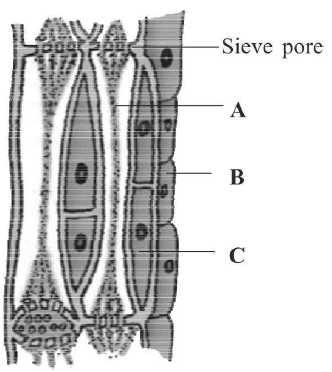
A. A
B. B
C. C
D. None of the above
Answer : C
in the sieve tubes.

A. A
B. B
C. C
D. None of the above
Answer : C
4. Xylem functions as a conducting tissue for water and minerals from _________to the ______and__________.
A. roots, stems, leaves
B. stems, roots, leaves
C. leaves, stems, roots
D. leaves, stems, leaves
Answer : A
A. roots, stems, leaves
B. stems, roots, leaves
C. leaves, stems, roots
D. leaves, stems, leaves
Answer : A
5. Which of the following statements are correct ?
A. (i) and (iii)
B. (i) and (ii)
C. (iii) and (iv)
D. (i) and (iv)
Answer : B
- Xylem transports water and minerals.
- Gymnosperms lack sieve tubes and companion cells in phloem.
- The first formed primary xylem is called metaxylem.
- Phloem fibres (bast fibres) are made up of collenchymatous cells.
A. (i) and (iii)
B. (i) and (ii)
C. (iii) and (iv)
D. (i) and (iv)
Answer : B
6. Which of the following pair of match is not correct?
A. Pith - Large and well developed in monocotyledonous root.
B. Root hairs - Helps in preventing water loss due to transpiration
C. Sieve tube elements - Its functions are controlled by the nucleus of companion cells.
D. Stomatal apparatus - Consists of stomatal aperture, guard cells and surrounding subsidiary cells
Answer : A
A. Pith - Large and well developed in monocotyledonous root.
B. Root hairs - Helps in preventing water loss due to transpiration
C. Sieve tube elements - Its functions are controlled by the nucleus of companion cells.
D. Stomatal apparatus - Consists of stomatal aperture, guard cells and surrounding subsidiary cells
Answer : A
7. Trees at sea do not have annual rings because
A. soil is sandy.
B. there is climatic variation.
C. there is no marked climatic variation.
D. there is enough moisture in the atmosphere.
Answer : C
A. soil is sandy.
B. there is climatic variation.
C. there is no marked climatic variation.
D. there is enough moisture in the atmosphere.
Answer : C
8. During the formation of leaves and elongation of stem, some cells left behind from the shoot apical meristem, constitute the
A. lateral meristem
B. axillary bud
C. cork cambium
D. fascicular cambium
Answer : B
A. lateral meristem
B. axillary bud
C. cork cambium
D. fascicular cambium
Answer : B
9. Which one of the following statement is incorrect ?
A. Only (i)
B. Only (iv)
C. Only (iii)
D. Only (v)
Answer : D
- Epidermal cell has small amount of cytoplasm and a large vacuole.
- Waxy cuticle layer is absent in roots.
- Root hairs are unicellular, while stem hairs / trichomes are multicellular.
- Trichomes may be branched or unbranched, soft or stiff and prevent transpiration.
- Guard cells are dumbell shaped in dicots and beanshaped in monocots (e.g. grass).
A. Only (i)
B. Only (iv)
C. Only (iii)
D. Only (v)
Answer : D
10. In land plants, the guard cells differ from other epidermal cells in having
A. cytoskeleton.
B. mitochondria.
C. endoplasmic reticulum.
D. chloroplasts.
Answer : D
A. cytoskeleton.
B. mitochondria.
C. endoplasmic reticulum.
D. chloroplasts.
Answer : D
11. A narrow layer of thin walled cells found between phloem/ bark and wood of a dicot is
A. cork cambium
B. vascular cambium
C. endodermis
D. both (a) & (c)
Answer : B
A. cork cambium
B. vascular cambium
C. endodermis
D. both (a) & (c)
Answer : B
12. The given diagrams show stomatal apparatus in dicots and monocots. Which one is correct option for A, B and C?

A. A Epidermal cells; B Subsidiary cells; C chloroplast
B. A Guard cells; B Subsidiary cells; C Stomatal pore
C. A Guard cells; B Epidermal cells; C Guard cells
D. A Epidermal cells; B Subsidiary cells; C Guard cells
Answer : D

A. A Epidermal cells; B Subsidiary cells; C chloroplast
B. A Guard cells; B Subsidiary cells; C Stomatal pore
C. A Guard cells; B Epidermal cells; C Guard cells
D. A Epidermal cells; B Subsidiary cells; C Guard cells
Answer : D
13. Lignin is the important constituent in the cell wall of
A. phloem
B. parenchyma
C. xylem
D. cambium
Answer : C
A. phloem
B. parenchyma
C. xylem
D. cambium
Answer : C
14. Read the following statements and answer the question.
Which type of wood is described by the above statements?
A. Sap wood
B. Heart wood
C. Spring wood
D. Autumn wood
Answer : C
- Cambium is very active and produces a large number of xylary elements having vessels with wider cavities.
- It is also called early wood.
- It is lighter in colour and has lower density.
Which type of wood is described by the above statements?
A. Sap wood
B. Heart wood
C. Spring wood
D. Autumn wood
Answer : C
15. Choose the correct labelling of (A J) in the given figure of T.S. of monocot root.

A. A Root hair, B Epiblema, C Cortex, D Endodermis, E Passage cell, F Pericycle, G Pith, H Phloem, I Metaxylem.
B. A Root hair, B Epiblema, C Cortex, D Endodermis, E Passage cell, F Pith, G Pericycle, H Metaxylem, I Phloem.
C. A Root hair, B Epiblema, C Cortex, D Endodermis, E Pericycle, F Phloem, G Protoxylem, I Metaxylem
D. A Root hair, B Cortex, C Epiblema, D Pericycle, E Endodermis, F Pith, G Phloem, H Protoxylem, I Metaxylem
Answer : C

A. A Root hair, B Epiblema, C Cortex, D Endodermis, E Passage cell, F Pericycle, G Pith, H Phloem, I Metaxylem.
B. A Root hair, B Epiblema, C Cortex, D Endodermis, E Passage cell, F Pith, G Pericycle, H Metaxylem, I Phloem.
C. A Root hair, B Epiblema, C Cortex, D Endodermis, E Pericycle, F Phloem, G Protoxylem, I Metaxylem
D. A Root hair, B Cortex, C Epiblema, D Pericycle, E Endodermis, F Pith, G Phloem, H Protoxylem, I Metaxylem
Answer : C
16. Which of the following statement(s) is/are not correct?
A. (iii) and (iv)
B. (i) and (ii)
C. (ii) and (iii)
D. (ii) and (iv)
Answer : A
- Cork cambium is also called phellogen.
- Cork is also called phellem.
- Secondary cortex is also called periderm.
- Cork cambium, cork and secondary cortex are collectively called phelloderm.
A. (iii) and (iv)
B. (i) and (ii)
C. (ii) and (iii)
D. (ii) and (iv)
Answer : A
17. Read the following statements and answer the question.
Which plant anatomy is being described by the above statements?
A. Dicotyledonous root
B. Monocotyledonous root
C. Dicotyledonous stem
D. Monocotyledonous stem
Answer : D
- It has a sclerenchymatous hypodermis, a large number of scattered vascular bundles and a large parenchymatous ground tissue.
- Vascular bundles are conjoint and closed.
- Peripheral vascular bundles are generally smaller than the centrally located ones.
- Phloem parenchyma is absent, and water- containing cavities are present within the vascular bundles.
Which plant anatomy is being described by the above statements?
A. Dicotyledonous root
B. Monocotyledonous root
C. Dicotyledonous stem
D. Monocotyledonous stem
Answer : D
18. Which of the following process helps the trichomes in preventing water loss?
A. Where companion cells helps in maintaining the pressure gradient in the sieve tubes.
B. Where plants absorb water through the roots and then give off water vapor through pores in their leaves.
C. Where activity of cork cambium builds pressure on the remaining layers peripheral to phellogen and ultimately these layers dies and slough off.
D. None of the above
Answer : B
A. Where companion cells helps in maintaining the pressure gradient in the sieve tubes.
B. Where plants absorb water through the roots and then give off water vapor through pores in their leaves.
C. Where activity of cork cambium builds pressure on the remaining layers peripheral to phellogen and ultimately these layers dies and slough off.
D. None of the above
Answer : B
19. The length of different internodes in a culm of sugarcane is variable because of
A. size of leaf lamina at the node below each internode
B. intercalary meristem
C. shoot apical meristem
D. position of axillary buds
Answer : B
A. size of leaf lamina at the node below each internode
B. intercalary meristem
C. shoot apical meristem
D. position of axillary buds
Answer : B
20. Identify A, B and C in the given figure of shoot apical meristem
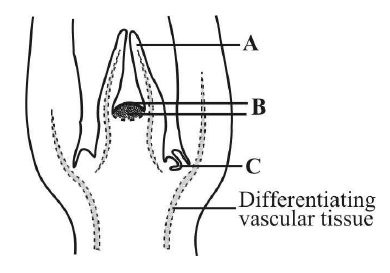
A. A Leaf primordium, B Shoot apical meristem, C Axillary bud
B. A Leaf primordium, B Shoot apical meristem, C Apical bud
C. A Root hair primordium, B Root apical meristem, C Axillary bud
D. A Root hair primordium, B Root apical meristem, C Terminal bud
Answer : A

A. A Leaf primordium, B Shoot apical meristem, C Axillary bud
B. A Leaf primordium, B Shoot apical meristem, C Apical bud
C. A Root hair primordium, B Root apical meristem, C Axillary bud
D. A Root hair primordium, B Root apical meristem, C Terminal bud
Answer : A
21. A piece of wood having no vessels (trachea) must be belonged to
A. teak
B. mango
C. pine
D. palm
Answer : C
A. teak
B. mango
C. pine
D. palm
Answer : C
22. A vascular bundle in which the protoxylem is pointing to the periphery is called __________.
A. endarch
B. exarch
C. radial
D. closed
Answer : B
A. endarch
B. exarch
C. radial
D. closed
Answer : B
23. Match the names of the structures given in column-I with the functions given in column-II, choose the answer which gives the correct combination of the two columns :
A. A V, B III, C I, D IV
B. A I, B IV, C V, D III
C. A II, B IV, C I, D III
D. A IV, B I, C III, D V
Answer : D
| Column-I | Column-II |
|---|---|
| (Structure) | (Function) |
| A. Stomata | I. Protection of stem |
| B. Bark | II. Plant movement |
| C. Cambium | III. Secondary growth |
| D. Cuticle | IV. Transpiration |
| V. Prevent the loss of water | ... |
A. A V, B III, C I, D IV
B. A I, B IV, C V, D III
C. A II, B IV, C I, D III
D. A IV, B I, C III, D V
Answer : D
24. Cork is formed from
A. phellogen
B. vascular cambium
C. phloem
D. xylem
Answer : A
A. phellogen
B. vascular cambium
C. phloem
D. xylem
Answer : A
25. In an experiment, a student cut a transverse section of young stem of a plant which he has taken from his school garden.
After observing it under the microscope how would he ascertain whether it is a monocot stem or a dicot stem?
A. With the help of bulliform cells.
B. With the help of casparian strips.
C. With the help of vascular bundles.
D. With the help of stomatal apparatus.
Answer : C
After observing it under the microscope how would he ascertain whether it is a monocot stem or a dicot stem?
A. With the help of bulliform cells.
B. With the help of casparian strips.
C. With the help of vascular bundles.
D. With the help of stomatal apparatus.
Answer : C
26. A tissue is a group of cells which are
A. similar in origin, but dissimilar in form and function.
B. dissimilar in origin, form and function.
C. dissimilar in origin, but similar in form and function.
D. similar in origin, form and function.
Answer : D
A. similar in origin, but dissimilar in form and function.
B. dissimilar in origin, form and function.
C. dissimilar in origin, but similar in form and function.
D. similar in origin, form and function.
Answer : D
27. Tissues are classified into two main groups, namely meristematic and permanent tissues on the basis of
A. whether the cells being able to divide or not.
B. position of the cells.
C. whether they are living or dead.
D. none of the above
Answer : A
A. whether the cells being able to divide or not.
B. position of the cells.
C. whether they are living or dead.
D. none of the above
Answer : A
28. Match column-I with column-II and choose the correct option.
A. A III, B V, C IV, D I, E II
B. A II, B V, C I, D III, E IV
C. A II, B IV, C I, D III, E V
D. A III, B I, C V, D II, E IV
Answer : D
| Column -I | Column -II |
|---|---|
| A. Bulliform cells | I. Initiation of lateral roots |
| B. Pericycle | II. Root |
| C. Endarch xylem | III. Grasses |
| D. Exarch xylem | IV. Dicot leaf |
| E. Bundle sheath cells | V. Stem |
A. A III, B V, C IV, D I, E II
B. A II, B V, C I, D III, E IV
C. A II, B IV, C I, D III, E V
D. A III, B I, C V, D II, E IV
Answer : D
29. The __________ occurs in layers below the epidermis in dicotyledonous plants.
A. parenchyma
B. sclerenchyma
C. collenchyma
D. aerenchyma
Answer : C
A. parenchyma
B. sclerenchyma
C. collenchyma
D. aerenchyma
Answer : C
30. Which one of the followings option shows the correct labelling of the parts marked as A, B, C and D in the given figure a lenticel?
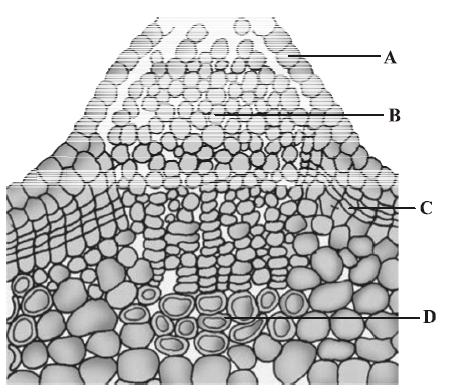
A. A Epidermis, B Secondary cortex, C Cork cambium, D Cork
B. A Pore, B Cork cambium, C Secondary cortex, D Cork
C. A Pore, B Cork, C Complimentary cells, D Cork cambium
D. A Epidermis, B Complimentary cells, C Cork cambium, D Secondary cortex
Answer : D

A. A Epidermis, B Secondary cortex, C Cork cambium, D Cork
B. A Pore, B Cork cambium, C Secondary cortex, D Cork
C. A Pore, B Cork, C Complimentary cells, D Cork cambium
D. A Epidermis, B Complimentary cells, C Cork cambium, D Secondary cortex
Answer : D
31. An organised and differentiated cellular structure having cytoplasm but no nucleus is called _________.
A. vessels
B. xylem parenchyma
C. sieve tubes
D. tracheids
Answer : C
A. vessels
B. xylem parenchyma
C. sieve tubes
D. tracheids
Answer : C
32. The trees growing in desert will
A. show alternate rings of xylem and sclerenchyma.
B. have only conjunctive tissue and phloem is formed by the activity of cambium.
C. show distinct annual rings.
D. not show distinct annual rings.
Answer : D
A. show alternate rings of xylem and sclerenchyma.
B. have only conjunctive tissue and phloem is formed by the activity of cambium.
C. show distinct annual rings.
D. not show distinct annual rings.
Answer : D
33. The given figure shows apical meristem of root apex with few part marked as A, B and C. Identify the correct labelling of A, B and C.
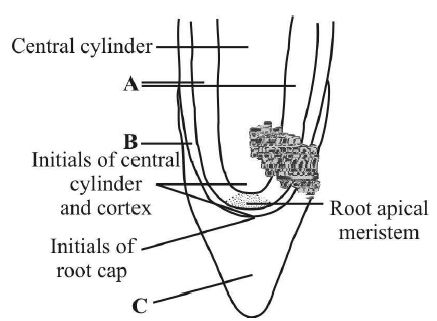
A. A Vascular structure, B Protoderm, C Root cap
B. A Cortex, B Endodermis, C Root cap
C. A Cortex, B Protoderm, C Root cap
D. A Tunica, B Protoderm, C Root cap
Answer : C

A. A Vascular structure, B Protoderm, C Root cap
B. A Cortex, B Endodermis, C Root cap
C. A Cortex, B Protoderm, C Root cap
D. A Tunica, B Protoderm, C Root cap
Answer : C
34. Apical and intercalary meristems are primary meristems because
A. they occur in the mature region of roots and shoots of many plants.
B. they made up of different kinds of tissues.
C. they involved in secondary growth.
D. they appear early in life of a plant and contribute to the formation of the primary plant body.
Answer : D
A. they occur in the mature region of roots and shoots of many plants.
B. they made up of different kinds of tissues.
C. they involved in secondary growth.
D. they appear early in life of a plant and contribute to the formation of the primary plant body.
Answer : D
35. Gymnosperms are also called soft wood spermatophytes because they lack
A. cambium
B. phloem fibres
C. thick-walled tracheids
D. xylem fibres
Answer : D
A. cambium
B. phloem fibres
C. thick-walled tracheids
D. xylem fibres
Answer : D
36. Match the followings and choose the correct option
A. A III, B IV, C I, D II
B. A I, B II, C III, D IV
C. A III, B II, C IV, D I
D. A III, B II, C I, D IV
Answer : A
| Column-I | Column-II |
|---|---|
| A. Cuticle | I. Guard cells |
| B. Bulliform cells | II. Outer layer |
| C. Stomata | III. Waxy layer |
| D. Epidermis | IV. Empty colourless cell |
A. A III, B IV, C I, D II
B. A I, B II, C III, D IV
C. A III, B II, C IV, D I
D. A III, B II, C I, D IV
Answer : A
37. Which meristem helps in increasing girth?
A. Lateral meristem
B. Intercalary meristem
C. Primary meristem
D. Apical meristem
Answer : A
A. Lateral meristem
B. Intercalary meristem
C. Primary meristem
D. Apical meristem
Answer : A
38. Phellogen and phellem respectively denote
A. cork and cork cambium,
B. cork cambium and cork,
C. secondary cortex and cork,
D. cork and secondary cortex,
Answer : B
A. cork and cork cambium,
B. cork cambium and cork,
C. secondary cortex and cork,
D. cork and secondary cortex,
Answer : B
39. Match the terms given in column I with their features given in column II and choose the correct option.
A. A - (i), B - (ii), C - (iii), D - (iv), E - (v)
B. A - (iii), B - (v), C - (ii), D - (iv), E - (i)
C. A - (iii), B - (i), C - (v), D - (ii), E - (iv)
D. A - (v), B - (iv), C - (iii), D - (i), E - (ii)
Answer : B
| Column-I | Column-II |
|---|---|
| (Terms) | (Features) |
| A. Fibres | (i) Cells are living and thin walled with cellulosic cell wall, store food materials in the form of starch or fat |
| B. Sclereids | (ii) Main water conductive cells of the pteridophytes and the gymnosperms |
| C. Tracheids | (iii) Thick walled, elongated and pointed cells, generally occurring in groups |
| D. Vessels | (iv) Long cylindrical tube like structure and cells are devoid of protoplasm. Characteristic feature of angiosperms |
| E. Xylem parenchyma | (v) Reduced form of sclerenchyma cells with highly thickened lignified cellular walls that form small bundles of durable layers of tissue in most plants. |
A. A - (i), B - (ii), C - (iii), D - (iv), E - (v)
B. A - (iii), B - (v), C - (ii), D - (iv), E - (i)
C. A - (iii), B - (i), C - (v), D - (ii), E - (iv)
D. A - (v), B - (iv), C - (iii), D - (i), E - (ii)
Answer : B
40. Some vascular bundles are described as open because these
A. are surrounded by pericycle but not endodermis.
B. are capable of producing secondary xylem and phloem.
C. possess conjunctive tissue between xylem and phloem.
D. are not surrounded by pericycle.
Answer : B
A. are surrounded by pericycle but not endodermis.
B. are capable of producing secondary xylem and phloem.
C. possess conjunctive tissue between xylem and phloem.
D. are not surrounded by pericycle.
Answer : B
41. Which of the following statement(s) is/are correct ?
A. (i) and (iv) only
B. (ii) and (v) only
C. (iii) and (iv) only
D. (ii), (iii) and (v) only
Answer : D
- Uneven thickening of cell wall is characteristic of sclerenchyma.
- Periblem forms cortex of the stem and the root.
- Tracheids are the chief water transporting elements in gymnosperms.
- Companion cell is devoid of nucleus at maturity.
- The commercial cork is obtained from Quercus suber.
A. (i) and (iv) only
B. (ii) and (v) only
C. (iii) and (iv) only
D. (ii), (iii) and (v) only
Answer : D
42. Which of the following are present in monocot root ?
A. conjoint, collateral, open polyarch vascular bundle.
B. exodermis, endarch, tetrarch closed vascular bundles.
C. suberized exodermis, casparian strip, passage cells, cambium.
D. suberized exodermis, polyarch xylem, pith.
Answer : D
A. conjoint, collateral, open polyarch vascular bundle.
B. exodermis, endarch, tetrarch closed vascular bundles.
C. suberized exodermis, casparian strip, passage cells, cambium.
D. suberized exodermis, polyarch xylem, pith.
Answer : D
43. Bast fibres are made up of _____________cells.
A. sclerenchymatous
B. chlorenchymatous
C. parenchymatous
D. aerenchymatous
Answer : A
A. sclerenchymatous
B. chlorenchymatous
C. parenchymatous
D. aerenchymatous
Answer : A
44. Which of the following figure is a type of permanent tissue having many different types of cell?
A.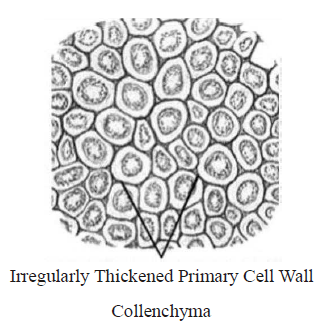
B.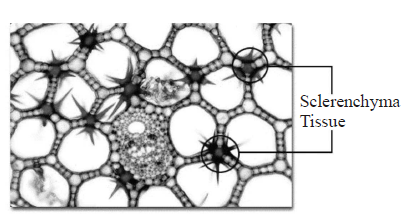
C.
D.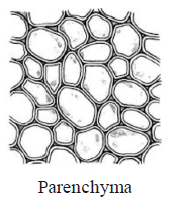
Answer : C
A.

B.

C.

D.

Answer : C
45. Which of the following is responsible for the formation of an embryonic shoot called axillary bud?
A. Lateral meristem
B. Apical meristem
C. Intercalary meristem
D. Both
Answer : C
A. Lateral meristem
B. Apical meristem
C. Intercalary meristem
D. Both
Answer : C
46. Sclerenchyma usually___________and_____________ protoplasts.
A. live, without
B. dead, with
C. live, with
D. dead, without
Answer : D
A. live, without
B. dead, with
C. live, with
D. dead, without
Answer : D
47. One of the primary function of the ground tissue in a plant is
A. photosynthesis.
B. to protect the plant.
C. to anchor the plant.
D. water and sugar conduction.
Answer : A
A. photosynthesis.
B. to protect the plant.
C. to anchor the plant.
D. water and sugar conduction.
Answer : A
48. A plant tissue when stained showed the presence of hemicellulose and pectin in cells wall of its cells. The tissue is called
A. collenchyma
B. sclerenchyma
C. xylem
D. meristem
Answer : A
A. collenchyma
B. sclerenchyma
C. xylem
D. meristem
Answer : A
49. The given figure shows T.S. of monocot stem. Identify the correct labelling of A to F marked in the given figure.
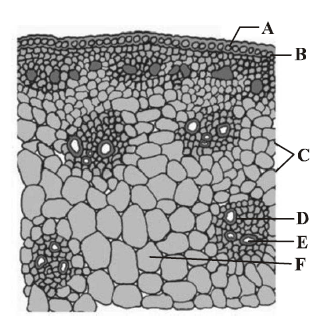
A. A Epidermis, B Hypodermis, C Vascular bundles, D Phloem, E Xylem, F Ground tissue
B. A Cuticle, B Epidermis, C Sclerenchymatous sheath, D Sclerenchymatous hypodermis, E Parenchymatous sheath, F Phloem
C. A Cuticle, B Epidermis, C Sclerenchymatous hypodermis, D Sclerenchymatous sheath, E Parenchymatous sheath, F Phloem
D. A Cuticle, B Epidermis, C Sclerenchymatous hypodermis, D Sclerenchymatous sheath, E Parenchymatous sheath, F Protoxylem
Answer : A

A. A Epidermis, B Hypodermis, C Vascular bundles, D Phloem, E Xylem, F Ground tissue
B. A Cuticle, B Epidermis, C Sclerenchymatous sheath, D Sclerenchymatous hypodermis, E Parenchymatous sheath, F Phloem
C. A Cuticle, B Epidermis, C Sclerenchymatous hypodermis, D Sclerenchymatous sheath, E Parenchymatous sheath, F Phloem
D. A Cuticle, B Epidermis, C Sclerenchymatous hypodermis, D Sclerenchymatous sheath, E Parenchymatous sheath, F Protoxylem
Answer : A
50. Cork cambium and vascular cambium are
A. the parts of secondary xylem and phloem.
B. the parts of pericycle.
C. lateral meristems.
D. apical meristems.
Answer : C
A. the parts of secondary xylem and phloem.
B. the parts of pericycle.
C. lateral meristems.
D. apical meristems.
Answer : C
Sharing is caring
Related Post
1000+ Articles MCQ for IBPS Clerk [Solved]
Asp Programming MCQ Solved Paper for SSC Stenographer
1000+ Steam Boilers, Engines, Nozzles & Turbines Multiple Choice Question Answer [Solved]
Engineering Mechanics MCQ Solved Paper for IBPS RRB
Word Power 1000+ MCQ with answer for NDA
NMAT - Selenium automation 1000+ MCQ [Solved] PDF Download